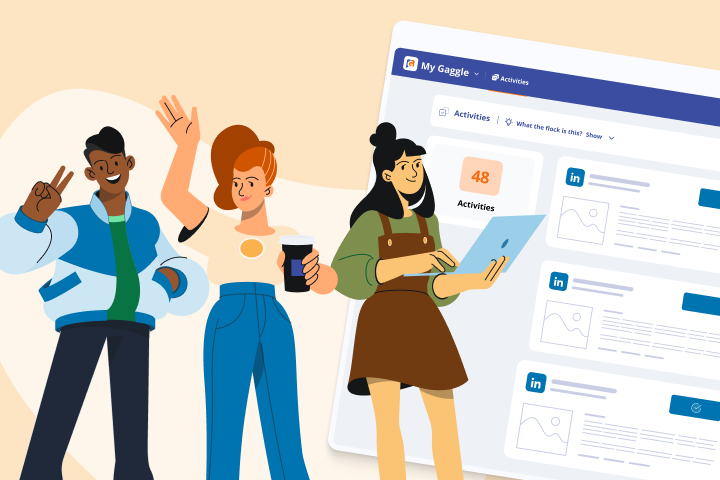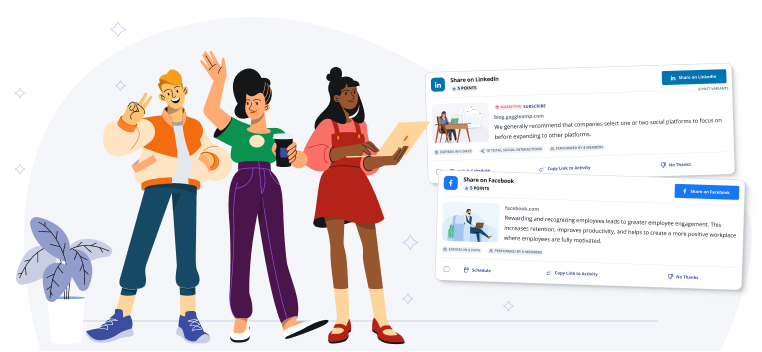Improving employer branding is tricky as it requires you to improve the perception of your brand in the eyes of employees, potential employees, and even customers.
Unfortunately, there are a lot of variables that influence that perception, many of which are out of your direct control.
In this post, we’ll discuss how you can approach employer brand management challenges and specific strategies you can use to predictably improve your employer branding for recruitment.
What Is Employer Branding in HR?
Employer branding in HR is the perception your employees have of your brand. Therefore, an effective employer branding strategy for HR can improve employee sentiment toward your company and increase employee retention.
What Is Employer Branding in Recruitment?
Employer branding in recruitment is a strategy used to improve the attractiveness of your company to potential employees. A successful employer branding strategy in recruitment will help you acquire better talent and reduce talent acquisition costs.
Why Is Employer Branding Important?
Employer branding is important because it helps you acquire better talent at a lower cost and increases employee retention.
As the talent and productivity of employees are among the significant variables that impact a company’s success, it’s hard to understate the importance of employer branding.
Some common employer branding initiatives include:
- Employee Advocacy: Encouraging employees to share what they like about working at your company.
- Customer Testimonials: Asking customers to write reviews and discuss online what they like about your brand.
- Promoting Workplace Awards: Promoting on social media and other platforms if your brand won any awards.
- Content Marketing: Promoting thought leadership content to establish your brand as an industry leader.
- Executive Personal Branding: Promoting your executives as key figures in the industry by boosting their social media presence and getting them on podcasts.
- Participating in Industry Events: Sending executives and key stakeholders to conferences and events (or even hosting your own events).
- Employee Referral Programs: Asking employees to actively recruit friends for job opportunities and offering an incentive for successful referrals.
How To Increase Employer Branding on Social Media
Whether your goal is to improve your brand’s position as a thought leader in the industry or attract A-player talent, social media is one of the best platforms to achieve your goal as that’s where all the attention already exists.
Following all of the best practice advice, like consistently posting valuable content, responding to comments, and engaging with other social media accounts, is a great start.
However, there are some specific employer branding ideas for social media that you can incorporate into your core social media strategy, which we'll discuss below.
Incorporate Employee Advocacy
Internal employer branding activities like asking your employees to post what they love about your brand on social media is one of the best ways to improve your employer branding. Real stories and testimonials from your employees are authentic and provide a behind-the-scenes look at what it's like to work for your brand. If you need some employer branding examples for LinkedIn, check out our guide to effective employer branding on LinkedIn.
Employee advocacy can also help improve employee retention rates by encouraging employees to pause and reflect on what they feel grateful to the company.
Build Your Executive’s Personal Brand
Building your executives’ personal brands on social media can also improve your employer branding efforts for a few reasons. First, executives with personal brands will have more followers, which gives your brand access to a bigger audience when you ask them to promote brand initiatives.
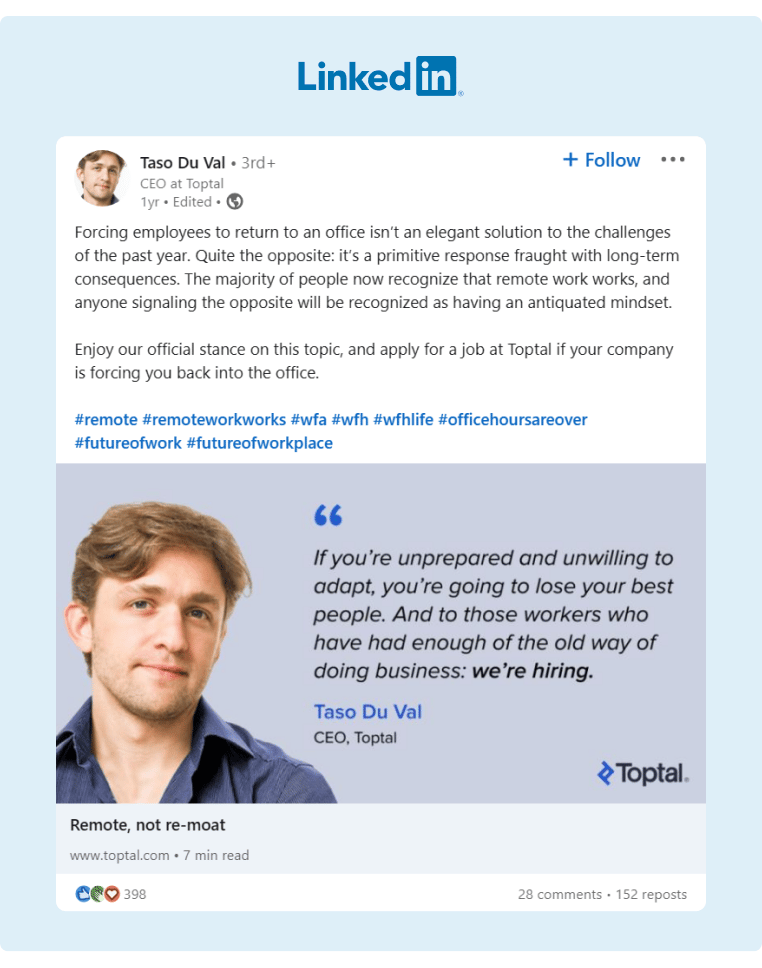
It’s also easier to attract top talent when your executives are well-established thought leaders, as most A-player candidates want to work with the brightest leaders in their industry.
Unfortunately, many executives are busy, and it can be difficult to convince them to take time to make content. To make it easier for them, assign specific employer branding activities with an employee advocacy tool. If you’re using a tool like GaggleAMP, it can even create automated content for you.
Promote the Company Culture
Posting content about your company's core values can help you attract candidates who align with those values, and it will also give your company more of a personality.
Many customers are also very conscious of the ethics of the companies they support, so promoting your values and workplace culture can also help improve customer retention.
You can also post about workplace awards and other achievements that show off third-party recognition of your company's outstanding culture.
Collaborate With Influencers
Collaborating with influencers is another great source for employer branding content ideas. Working with influencers boosts your brand's credibility and industry authority, which are essential components for a strong employer brand. It also allows you to tap into their audience, further increasing brand awareness.
You can collaborate with influencers through guest interviews, collaborative data studies, and joint webinars to boost your social media employer branding.
Below we'll discuss more employer branding activities and examples across social media.
Employer Branding Content Strategy
Now that you have some employer branding ideas, let’s walk through a comprehensive, step-by-step content strategy plus some employer branding strategy examples.
Step 1: Define Your Goals and Objectives
First, establish your goals and KPIs to measure your strategy's effectiveness and optimize and improve it.
Some common goals for an employer branding content strategy include:
- Improving employee retention.
- Increasing employee candidate quality and volume.
- Improving share of voice across the industry.
- Increasing brand awareness.
For each of those metrics, assign a specific KPI.
For example, if improving brand awareness is a specific goal, some KPIs you might want to track include:
- Branded organic search volume.
- Company page followers.
- Branded mentions on social media.
- Direct website traffic.
Next, set up tracking for each of those KPIs as we'll evaluate each of them in step five of this process.
Step 2: Establish a Consistent Content Workflow and Schedule
If you don't publish consistently, your new followers will forget who you are and become disengaged. Building a relationship with your audience is also much more difficult if you aren't consistently communicating with them.
It's similar to making friends – if you meet someone but fail to follow up and continue seeing that person, it will be difficult to build a strong relationship.
So, before you start creating content, develop a content calendar and workflow plan to ensure you're publishing consistently.
During this stage, first, map out the type of content you want to create (video, text-based, etc.) and the platforms you plan to publish on (LinkedIn, Instagram, X, etc.).
As you develop your content plan, consider:
- What type of content can your brand produce sustainably (e.g., don't select video if you know you can’t consistently produce video content)?
- What platforms is my audience currently using?
- Does the content format we want to produce match the platform we intend to use (e.g., if you plan to use primarily video content, X might not be the best platform)?
Once you've decided the type of content you want to produce, create a workflow so that each team member understands their responsibilities to ensure each piece of content is published on time.
From there, you can create a social media content calendar based on each team member's capacity. It's essential to establish a realistic publishing frequency. If the publishing frequency is too ambitious, your team will burn out and give up before seeing any traction. So, be sure to ask your team for their feedback on the workflow process and schedule.
Then, assign each task using a project management tool like Trello or Basecamp. Project management tools make it easier to stay organized and hold team members accountable as you'll clearly understand exactly where breakdowns occur if the content publishing schedule gets off track.
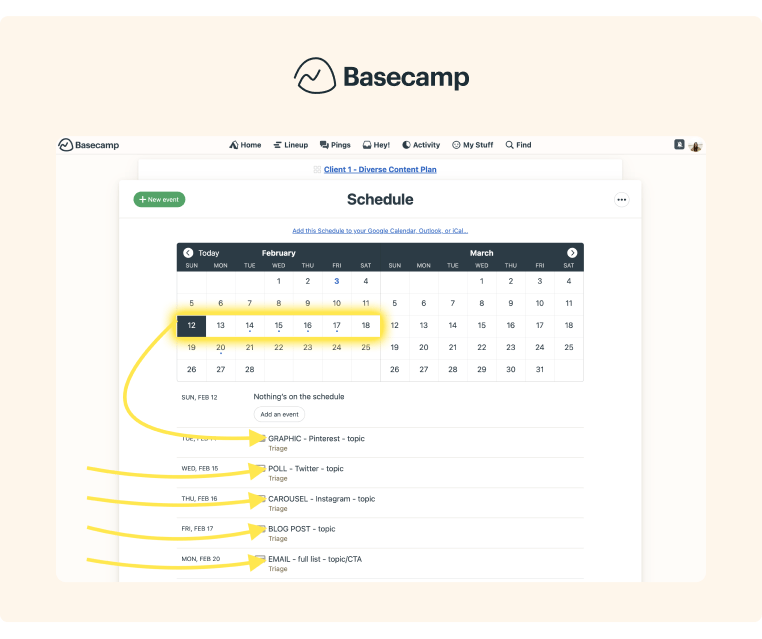
Source: Basecamp
Step 3: Content Ideation
Now that you have a content publishing workflow and know the specific platforms you plan to publish on, the next step is to figure out the content ideas that will help you achieve your employer branding goals.
Here are a few specific content ideas geared toward employer branding that you can incorporate into your calendar:
- Workplace award achievements.
- Culture and company off-site reflections.
- Employee achievement and spotlight posts.
- Company achievement posts (funding announcements, new executive hires, etc.).
- Customer case studies and testimonials.
- Behind-the-scenes posts.
- Diversity and inclusion activities.
- Thought leadership content.
It's also important to realize that top talent usually prioritizes working at companies that are leaders in their field. Publishing thought leadership content, company achievements, and other content that clearly shows your company is a market leader is excellent for retaining and attracting top talent.
Even interviewing executives within the company to get their thoughts on current market trends is a great way to showcase your company's expertise and authority.
Step 4: Employee Advocacy
Consistently publishing great content is essential to retaining an audience, but getting your content in front of people to earn new followers can be challenging. To solve this problem, create a content distribution system.
There are plenty of content distribution strategies, like influencer marketing, partnership marketing, and even running sharing contests.
However, our preferred content distribution method for employer branding is employee advocacy. Employee advocacy is when employees engage with content from your brand or create their own content about your brand.
Here are a few reasons why it's a highly effective content distribution method for employer branding:
-
It’s Higher Quality Engagement. Employees tend to have deeper connections with their community than influencers or partner brands have with their audiences. As a result, you'll usually see higher-quality engagement from your employees' shares.
-
It’s Cost Effective. Employee advocacy is cost effective as you don't have to pay employees a fee to share content. They're usually happy to share as they also want their employer to succeed as that reflects well on their resume.
-
It’s Authentic. Employee advocacy is one of the most authentic forms of content distribution, as employees' followers know they aren't paid to share the content. In addition, your employees' connections want them to succeed, so they're more likely to engage with the content simply to support their friends. This is good news for your brand as it helps that content achieve even more reach thanks to those connections' engagement.
However, keeping employees engaged can be challenging. Many are busy and forget to engage, while others simply don't know how to engage or create content.
The good news is that you can solve all these problems using an employee advocacy tool like GaggleAMP. It lets social media managers send personalized engagement activities to specific employees or groups of employees.
To get started, GaggleAMP allows you to select an engagement activity (e.g., share, like, comment, etc.) for a specific platform (e.g., Instagram, X, LinkedIn, Pinterest, etc.).
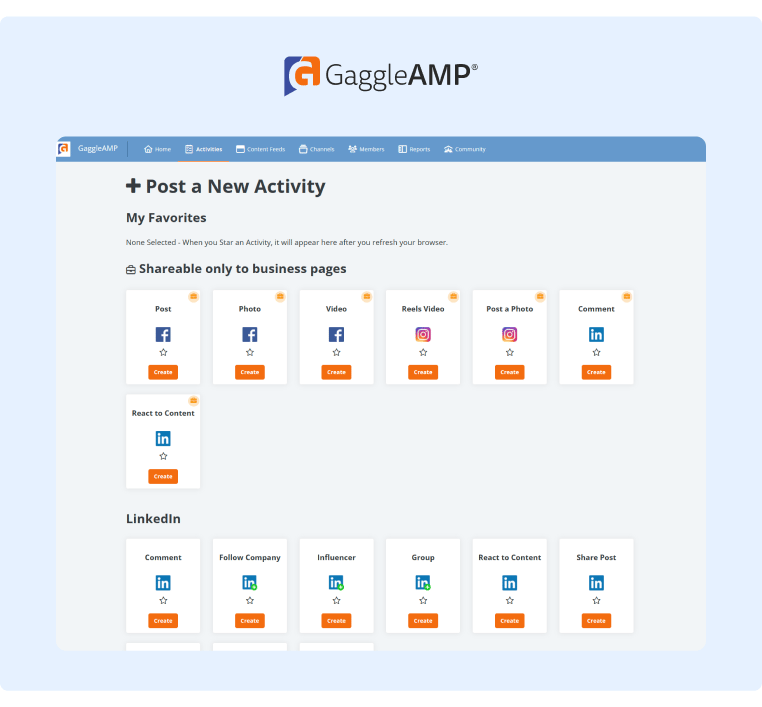
Then, you can fill it out with specific instructions, like guidelines on what to say. In fact, there's even an AI-powered paraphrase that allows you to create alternative text for posts or to give that power to your Gaggle Members. Providing pre-written text is particularly effective at increasing engagement as employees won't have to think of anything to say. They can just look at the text you've generated and either edit it or approve it.
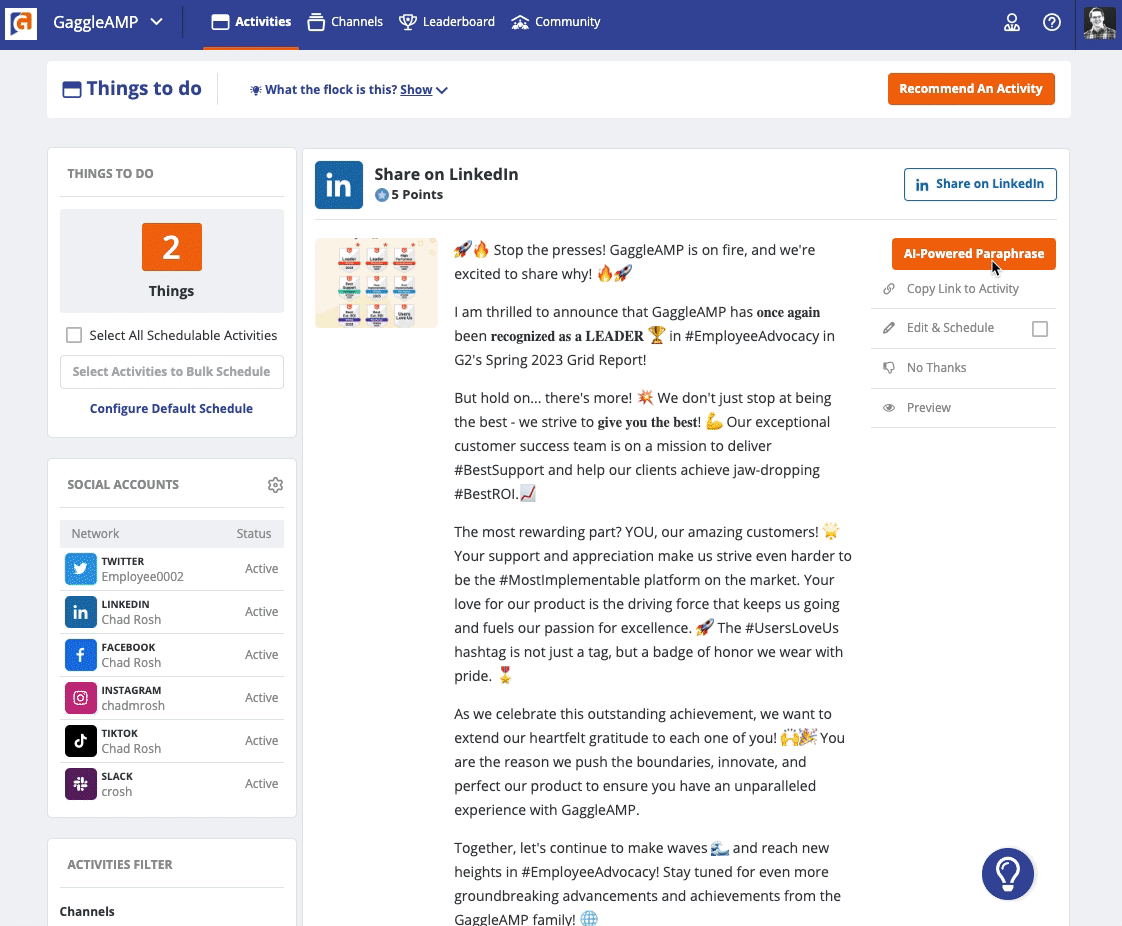
Once you've completed the engagement activity, you can add a due date and assign it to a specific employee or group of employees (e.g., the marketing team, executives, etc.).
Those recipients will then receive a notification (via Slack, Microsoft Teams, or email – your preference) and can log into their personal Gaggle to see the engagement activities.
They can then choose to edit the activities or schedule them to publish as is.
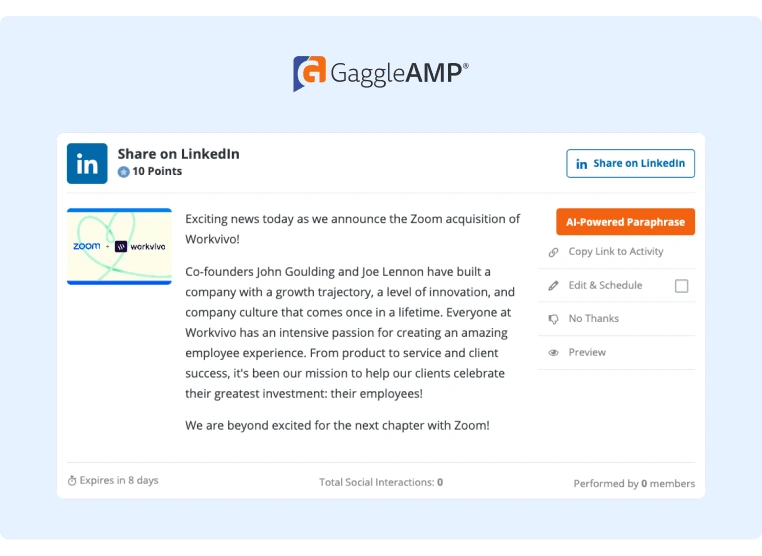
Providing specific engagement instructions and pre-written content significantly reduces the effort required from employees to participate in your employee advocacy program. Therefore, employees are much more likely to participate, and you'll see higher engagement rates.
GaggleAMP also tracks employee engagement rates so that managers can identify and reward actively engaged employees and offer support for those who aren't engaged.
The public leaderboard also calculates the most engaged employees and allows you to incorporate gamification to further boost employee engagement.
To see for yourself how GaggleAMP can help you achieve your employer branding goals, you can book a demo today.
Step 5: Measure Results and Test
There are plenty of different employer branding best practices, but you'll have to test different strategies to determine which works best for your brand and audience.
If you're starting your content strategy from scratch, you probably won't see any significant improvements in the first few months.
However, after about six months, take note of which campaigns performed the best and double down on creating more similar content.
As you're measuring the effectiveness of your content, be sure to measure not only the quantity of engagement but also the quality of engagement.
For example, look at who engages with your content and what they say about your brand. Even if you don't have a lot of engagement just yet, these quality metrics can signal if your content strategy is heading in the right direction.
Best Employer Branding Examples
To inspire your employer branding strategy, below we’ll discuss a handful of outstanding employer branding case studies and explore specific tactics from each one that you can implement in your strategy.
Example #1: WSC Sports
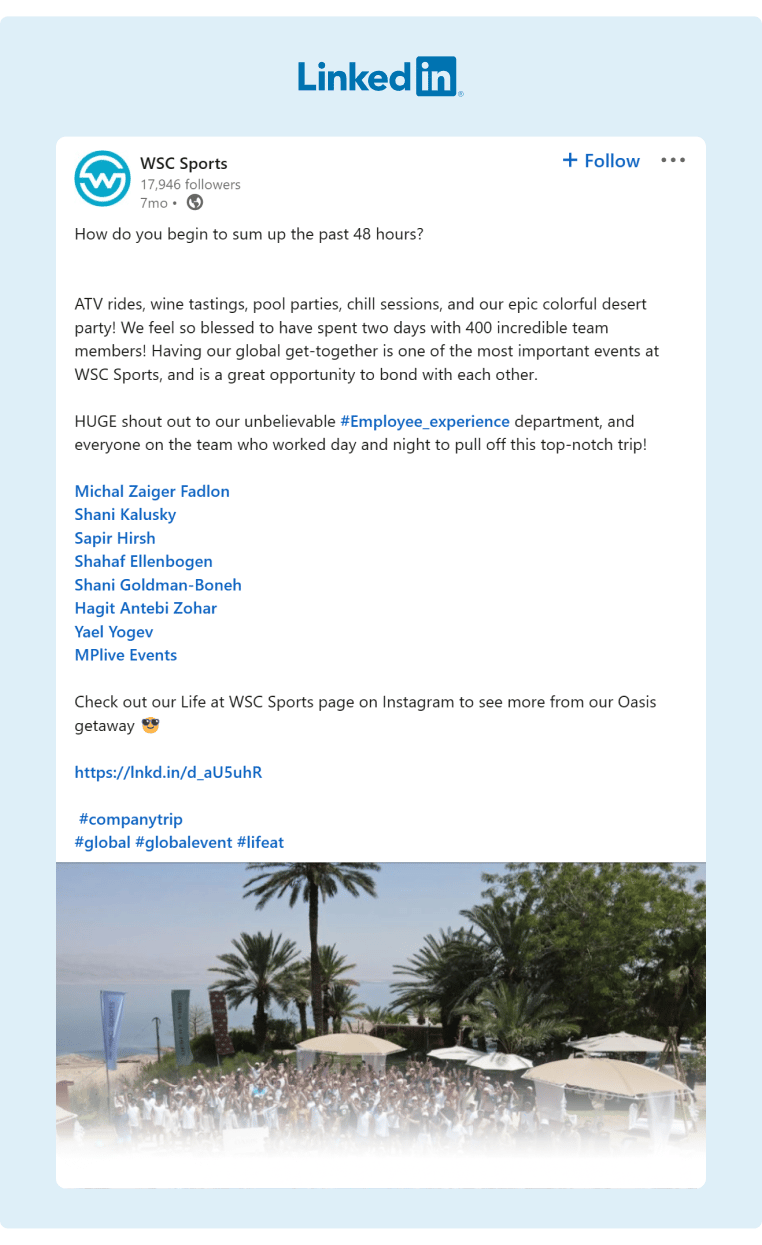
This post is an excellent example of employer branding. Here, the brand shares a company off-site experience.
The post was also well optimized for engagement: it includes a photo, tags relevant people, and contains several relevant hashtags. You can also see that their employees jumped into the comments section to help it earn more reach and engagement:

Source: WSC Sports
Example #2: Caroo
Caroo is an HR platform, and this post from their CEO is an excellent example of employer branding. Instead of simply promoting that the company is considering a four-day work week and therefore prioritizes employee wellness, the CEO explains why they're making the shift and the results from a trial period.
This makes the content more engaging than traditional promotional content, and it generated over 20 comments and 100 likes.
It was also clever to have the CEO share the content first and then reshare it to the brand page. Here’s why: individual executive profiles tend to generate more engagement than branded company pages simply because people prefer to interact with other people on social media rather than brands.
Finally, the employees also joined in the discussion, which improved the post's engagement and also elevated the company's image. You can see that the comments are a testament to the company's excellent culture.
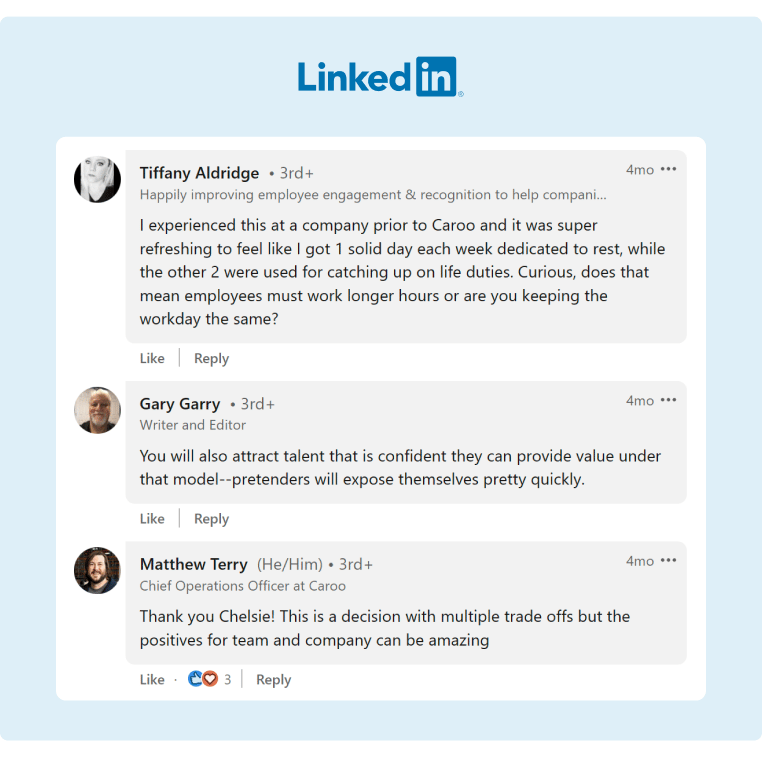
Source: Chelsie Rae Lee
Example #3: Lakeshore Learning
In this post, a retail manager for the brand published a heartwarming post about the impact her brand makes on the local community.
This is an outstanding example of employee advocacy, and you can see that it is an authentic presentation of the brand's identity and impact.
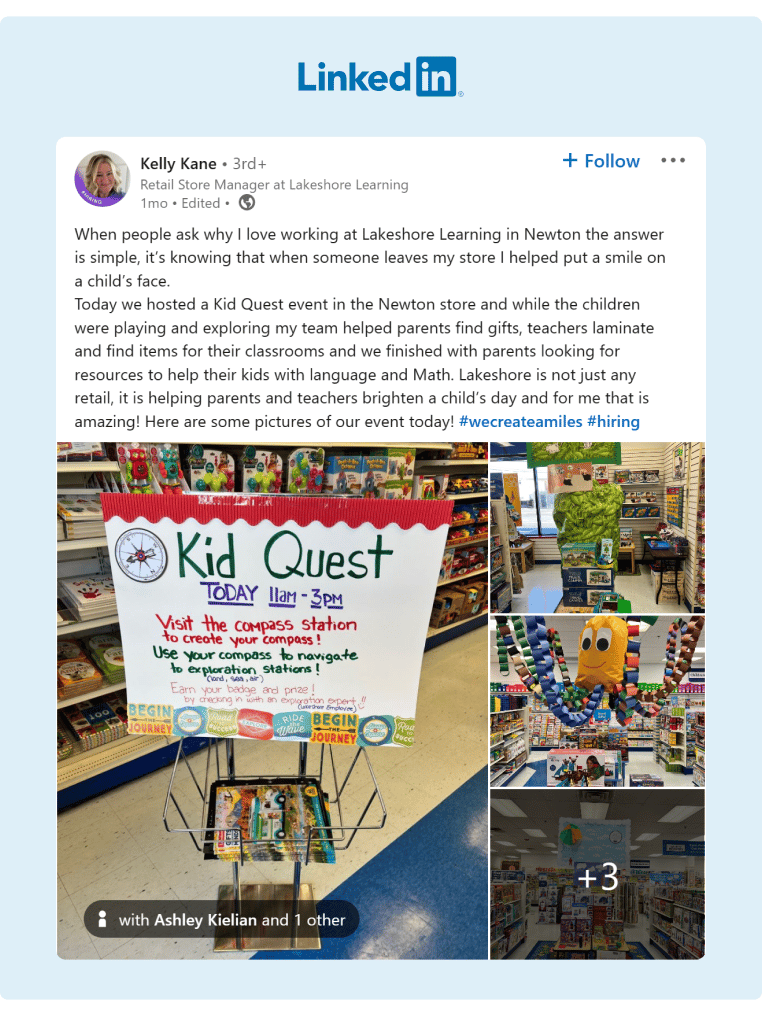
Source: Kelly Kane
The photos also help capture social media users' attention and make the post stand out from all branded graphics they likely see in their feed.
Some of her co-workers also jumped into the comments to further praise the brand and the colleague:
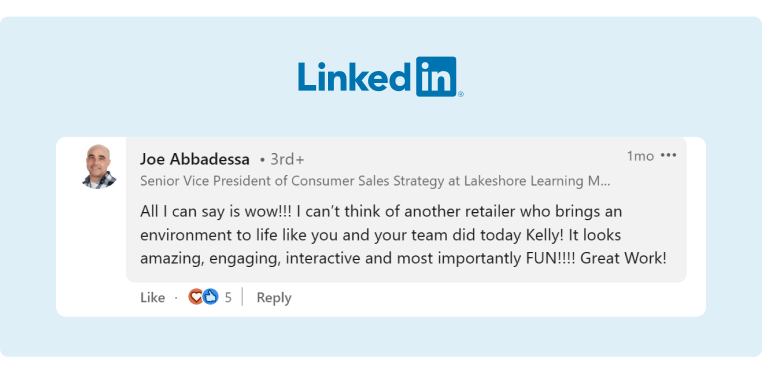
Source: Kelly Kane
Example #4: Merrick & Company
Diversity and inclusion posts are also helpful for attracting and retaining talent. This post by Merrick & Company is an excellent example of how you can promote your company's stance on diversity and conclusion.
Rather than just stating that they support diversity and inclusion, they created a carousel on psychological safety and what it means to the brand. This is an engaging topic and the post is also very well optimized with attractive graphics. Finally, the brand's employees also jumped in and reshared the post with their audiences, stating why they like working at the company:
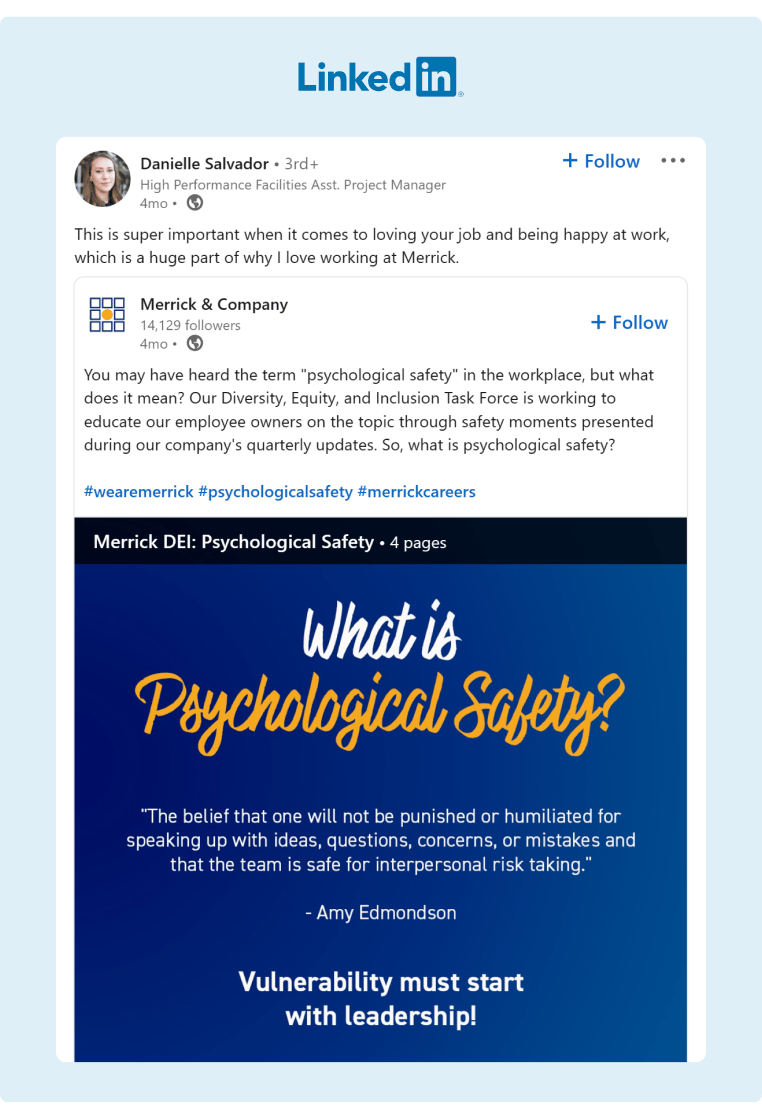
Source: Danielle Salvador
Example #5: Shopify
Promoting the company’s culture is important to employer branding, but it’s also critical to show your audience that your company is an industry leader.
Shopify does a great job of this by collaborating with industry leaders and sharing some of the exciting new AI technologies they’re incorporating into the product.

Source: Shopify
The post is also well optimized for social media, as they include a video clip with subtitles to increase engagement and they also tag the influencer involved.
Start Improving Your Employer Branding Efforts Today
There are plenty of different tactics to improve employer branding, but if you want to produce long-term results, you need a sustainable strategy – not just tactics.
While influencer marketing and other collaborations can be helpful, we’ve found that the most sustainable employer branding strategy is using employee advocacy. Not only is it authentic, making it highly effective at improving your employer brand, but it is also one of the most cost-effective approaches to improving employer branding.
The only challenge is keeping your employees engaged with the program. To improve employee engagement, we built GaggleAMP, which is an employee advocacy tool that significantly reduces the effort required from employees to participate in your employee advocacy program.
Instead of asking your employees to think of content ideas and create content, it allows you to assign specific engagement activities and even use our AI to pre-write content for Members. Then, all they have to do is approve and publish it.
Best of all, it only takes you a few minutes to create engagement activities and assign them to different groups of employees.
You can learn more about how GaggleAMP works by scheduling a demo today.







